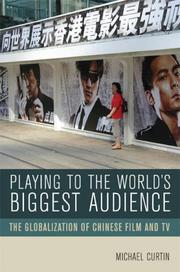| Listing 1 - 10 of 16 | << page >> |
Sort by
|

ISBN: 9780520251335 9780520251342 Year: 2007 Publisher: Berkeley, Calif. University of California Press
Abstract | Keywords | Export | Availability | Bookmark
 Loading...
Loading...Choose an application
- Reference Manager
- EndNote
- RefWorks (Direct export to RefWorks)
Film --- Mass communications --- China --- Motion pictures --- Motion picture industry --- Television broadcasting --- Cinéma --- Télévision --- Industrie --- 82:791.43 --- S17/2000 --- 82:791.43 Literatuur en film --- Literatuur en film --- China: Art and archaeology--Film --- Cinéma --- Télévision --- Telecasting --- Television --- Television industry --- Broadcasting --- Mass media --- Film industry (Motion pictures) --- Moving-picture industry --- Cultural industries

ISBN: 1282445766 1429494581 9786612445767 0520940733 1433708779 9780520940734 0520251334 9780520251335 0520251342 9780520251342 9781429494588 9780520251335 9780520251342 Year: 2007 Publisher: Berkeley University of California Press
Abstract | Keywords | Export | Availability | Bookmark
 Loading...
Loading...Choose an application
- Reference Manager
- EndNote
- RefWorks (Direct export to RefWorks)
In this provocative analysis of screen industries in China, Hong Kong, Taiwan, and Singapore, Michael Curtin delineates the globalizing pressures and opportunities that since the 1980's have dramatically transformed the terrain of Chinese film and television, including the end of the cold war, the rise of the World Trade Organization, the escalation of democracy movements, and the emergence of an East Asian youth culture. Reaching beyond national frameworks, Curtin examines the prospect of a global Chinese audience that will include more viewers than in the United States and Europe combined. He draws on in-depth interviews with a diverse array of media executives plus a wealth of historical material to argue that this vast and increasingly wealthy market is likely to shake the very foundations of Hollywood's century-long hegemony. Playing to the World's Biggest Audience profiles the leading Chinese commercial studios and telecasters, and delves into the operations of Western conglomerates extending their reach into Asia. Advancing a dynamic and integrative theory of media capital, this innovative book explains the histories and strategies of screen enterprises that aim to become central players in the Global China market and offers an alternative perspective to recent debates about cultural globalization.
Motion picture industry. --- Motion pictures. --- Television broadcasting. --- Motion pictures --- Motion picture industry --- Television broadcasting --- Telecasting --- Television --- Television industry --- Broadcasting --- Mass media --- Film industry (Motion pictures) --- Moving-picture industry --- Cultural industries --- business and industry. --- capitalism. --- capitalist paternalism. --- china. --- chinese commercial studios. --- chinese film. --- chinese media. --- chinese television. --- cold war. --- cultural globalization. --- cultural studies. --- east asian youth culture. --- economics. --- global china market. --- global chinese audience. --- globalization. --- history. --- hong kong cinema. --- hong kong. --- independent studios. --- infrastructure. --- media capital. --- media studies. --- multimedia. --- pan chinese studio system. --- screen industry. --- singapore. --- taiwan. --- world trade organization.

ISBN: 0824078039 Year: 1987 Publisher: New York Garland
Abstract | Keywords | Export | Availability | Bookmark
 Loading...
Loading...Choose an application
- Reference Manager
- EndNote
- RefWorks (Direct export to RefWorks)
Book
ISBN: 1841156051 Year: 2002 Publisher: London Fourth Estate
Abstract | Keywords | Export | Availability | Bookmark
 Loading...
Loading...Choose an application
- Reference Manager
- EndNote
- RefWorks (Direct export to RefWorks)
Book
Year: 1980 Publisher: London
Abstract | Keywords | Export | Availability | Bookmark
 Loading...
Loading...Choose an application
- Reference Manager
- EndNote
- RefWorks (Direct export to RefWorks)

ISBN: 0415911222 Year: 1997 Publisher: New York, N.Y. Routledge
Abstract | Keywords | Export | Availability | Bookmark
 Loading...
Loading...Choose an application
- Reference Manager
- EndNote
- RefWorks (Direct export to RefWorks)
Mass communications --- anno 1960-1969 --- United States --- United States of America
Book
ISBN: 9781844573370 9781844573387 Year: 2009 Publisher: London BFI
Abstract | Keywords | Export | Availability | Bookmark
 Loading...
Loading...Choose an application
- Reference Manager
- EndNote
- RefWorks (Direct export to RefWorks)
Industrial economics --- Mass communications --- United States --- Television broadcasting --- Technological innovations. --- United States of America
Book
ISBN: 0520968190 9780520968196 0520295439 9780520295438 2016056134 Year: 2017 Publisher: Oakland, California University of California Press
Abstract | Keywords | Export | Availability | Bookmark
 Loading...
Loading...Choose an application
- Reference Manager
- EndNote
- RefWorks (Direct export to RefWorks)
"The film industry in Hollywood now employs a global mode of production run by massive media conglomerates that mobilize hundreds, sometimes thousands, of workers for each feature film or television series. Yet these workers and their labor remain largely invisible to the general audience. In fact, this has been a signal characteristic of Hollywood style for more than a hundred years: everything that matters happens onscreen, not off. Consequently, when it comes to movies and television, the voices heard most often are those belonging to talent and corporate executives. Those we hear least are the voices of labor, and it's that silence we aim to redress in the collection of interviews in this book. Drawing from the detailed and personal accounts in this collection, we offer three interrelated propositions about the current state and future prospects of craftwork and screen media labor: 1. Craftwork exists within an intricate and intimate matrix of social relations. 2. Hollywood craftwork today constitutes a regime of excessive labor. 3. Screen media production is a protean entity. We organized the collection into three sections: company town, global machine, and fringe city. The first section refers to Hollywood's historic roots as a core component of the motion picture business. The second section engages more directly with the spatial dynamics of film and television production to underscore the economic and political structures that are integrating distant locations into the studios' mode of production. We close with a section on the visual effects sector, in which stories shared by vfx artists, advocates, and organizers specifically illustrate how the industry today relies on marginal institutions to sustain its power and profitability"--Provided by publisher.
Motion picture industry --- Mass media and globalization. --- Employees --- Globalization and mass media --- Globalization --- Film industry (Motion pictures) --- Moving-picture industry --- Cultural industries --- SOCIAL SCIENCE / Media Studies. --- artists. --- behind the scenes. --- blue collar. --- business. --- conglomerates. --- craftwork. --- feature film. --- film industry. --- historic roots. --- history. --- hollywood. --- interviews. --- media. --- motion picture. --- movies. --- personal accounts. --- power. --- production. --- profitability. --- screen media. --- social relations. --- studios. --- style. --- television series. --- tv. --- vfx. --- visual effects. --- workers.
Book
ISBN: 0520964802 9780520964808 9780520290853 0520290852 Year: 2016 Publisher: Oakland, California University of California Press
Abstract | Keywords | Export | Availability | Bookmark
 Loading...
Loading...Choose an application
- Reference Manager
- EndNote
- RefWorks (Direct export to RefWorks)
"Precarious Creativity examines the seismic changes confronting media workers in an age of globalization and corporate conglomeration. This pathbreaking anthology peeks behind the hype and supposed glamor of screen media industries to reveal the intensifying pressures and challenges confronting actors, editors, electricians, and others. The authors take on pressing conceptual and methodological issues while also providing insightful case studies of workplace dynamics regarding creativity, collaboration, exploitation, and cultural difference. Furthermore, it examines working conditions and organizing efforts on all six continents, offering broad-ranging and comprehensive analysis of contemporary screen media labor in such places as Lagos, Prague, Hollywood, and Hyderabad. The collection also examines labor conditions across a range of job categories that includes, for example, visual effects, production services, and adult entertainment. With contributions from such leading scholars as John Caldwell, Vicki Mayer, Herman Gray, and Tejaswini Ganti, Precarious Creativity offers timely critiques of media globalization while also intervening in broader debates about labor, creativity, and precarity"--Provided by publisher.
Labor and globalization --- Mass media and globalization --- Mass media --- Cultural industries --- Precarious employment --- Industries --- Business & Economics --- Globalization and mass media --- Globalization --- Globalization and labor --- Employment, Precarious --- Labor --- Creative industries --- Culture industries --- Employees --- Social aspects --- SOCIAL SCIENCE / Media Studies. --- adult entertainment. --- analysis. --- anthology. --- collaboration. --- conglomerations. --- corporate. --- creativity. --- cultural difference. --- culture. --- exploitation. --- globalization. --- herman gray. --- hollywood. --- hyderabad. --- international. --- john caldwell. --- labor conditions. --- labor. --- lagos. --- luminos. --- media production. --- media workers. --- media. --- modern world. --- political science. --- prague. --- screen media. --- tejaswini ganti. --- true story. --- university of california. --- vicki mayer. --- visual effects. --- worldwide. --- Mass media and globalization. --- Labor and globalization. --- Social aspects. --- Employees. --- Non-standard employment
Book
ISBN: 9780252035012 9780252076909 Year: 2010 Publisher: Urbana, Ill. University of Illinois Press
Abstract | Keywords | Export | Availability | Bookmark
 Loading...
Loading...Choose an application
- Reference Manager
- EndNote
- RefWorks (Direct export to RefWorks)
Mass communications --- China --- India
| Listing 1 - 10 of 16 | << page >> |
Sort by
|

 Search
Search Feedback
Feedback About UniCat
About UniCat  Help
Help News
News